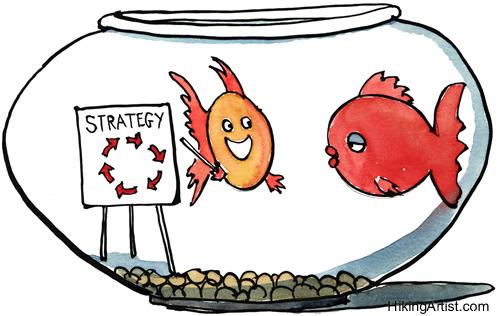(S)TRATEGIES
I had realized that I was teaching a nuanced (S)ubject, but I also had realized that I had to be teaching a wide variety of precisely defined (S)kills in combination with that subject. However, I could also tell as I team taught with master teachers each spring that they had a lot more going on in their classrooms than just that.
The biggest difference between my students and their students was that my students now had a deeper knowledge base that called upon a wider range of skills than just short term memory, but they didn't really have what I would have called understanding. They knew things, but they didn't understand them.
One of the more curious remarks I remember when I started asking older teachers about "knowing versus understanding" came from a high-powered Advanced Placement teacher whose students always got 4's or 5's on their tests, "I wouldn't worry about it; you don't have to understand anything in high school, you just have to know a lot of stuff. In fact, if you start to understand it, your performance might go down." I have always wondered whether, in fact, he was correct, but I have never been able to subscribe to the ideal behind it.

Part of the difference between knowing and understanding something seemed to be being the difference between being skilled and being strategic. Certainly, I had people on my soccer teams who were skilled but were not what my own British coaches referred to simply as "players." To be only highly skilled was not enough to understand the game or how to play it. But what did being a "player" look like in the classroom? It was not, obviously, to be good at simply being a student, it was to be good at being a learner.
There seemed to be two major elements that were missing from achieving understanding and from learning how to learn--choice and design. Choice provided motivation and dynamism; design provided creativity and direction. And as I looked around it became apparent that my students got to make very few choices and they rarely designed something. The other day at an opening CITYterm advisee meeting with parents and students, I was trying to explain what was different about experience-based learning and asked, "When was the last time you designed something in your school?" The answer was a kind of embarrassed silence. But that is the response I get all the time from students at schools all over the country. Design is one of the essential parts of creativity; it is why teachers love making up paper topics, but hate grading papers. But it is not something in the daily cognitive diet of high school students in classrooms. Ironically, it is something that does exist in what are often mistakenly labeled "extra-curricular activities."
(S)TUDENTS
The idea of being a good learner struck with me in a way that has never left. So much of what I was doing was about learning how to learn--about anything and everything. That was, in fact, the single most important skill of a sustainable education. But in order to be able to do that you had to have two other skills--being meta-cognitive and being able to self-assess.
I could know my subject, tease out the embedded skills, and develop strategies, but my students were too reliant upon me in a way that my players were not. But I had made them that way in one dramatic way--I rarely allowed them to assess their own work. I had generated a dependency, and with it, a severe blow to their confidence. The players on my teams had attitude; they had confidence tempered with humility. My students did not.
Once my students started thinking about their own thinking (meta-cognition) and self-assessing their own work, then they could create their own cognitive profiles. This was a dramatic change to the tone of class. But it ramped up the challenge of teaching immeasurably. Now I had to be watching myself teach; I had to be in the "balcony" while participating on the "dance floor" at the same time. Every student was now definably individual because they processed with radically different cognitive processes. If I were going to teach each individual I had to listen to WHAT they were saying, but then I had to infer HOW they had arrived at that understanding. This added a layer to the classroom that I do not think I will ever exhaust.
(S)ELF
The move to being both in the balcony and on the dance floor unearthed a truth that I had long suspected, but now stared glaringly back at me--I was teaching "myself" as well. But that needed to be understood in a couple of different ways, and will need a fuller development in a different blog post.
No comments:
Post a Comment